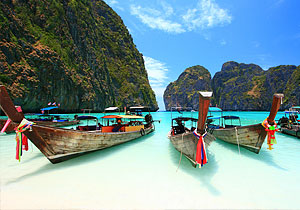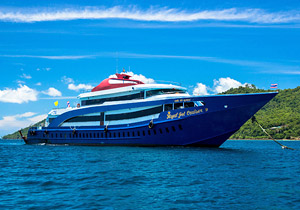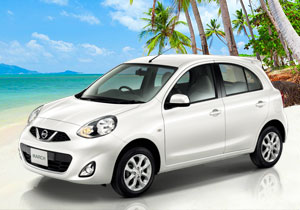Phuket is Thailand's biggest and possibly its best-known island. With a vibrant and colourful history, a unique culture and stunning natural attractions - both on the island and immediately around it - it is one of the leading tourist attractions of the Land of Smiles, drawing people from around the world.
While the attraction of Phuket is now its many beautiful beaches, it was no so long ago that people came just for the island's natural resources. Tin mining first attracted settlers and traders from China, as well as Singapore and Penang. The Hokkien Chinese who stayed blended their own culture with the others around them, creating Phuket Town's colourful Sino-Portuguese architecture, as well as the numerous Chinese shrines and pagodas and the unique cuisine and famous annual Vegetarian Festival.
As the mineral resources dried up and tourism began to increase, new attractions were constantly discovered around Phuket, including Phang Nga Bay and the Phi Phi Islands, but also smaller delights like Koh Racha, Koh Hey and Koh Khai, among others. However, even though an international airport and five-star resorts now supply the bulk of Phuket's income, there are still some traditional practises and industries, including rubber, pineapple, cashew and coconut plantations, as well as fisheries and aqua farms along the east coast for delivering the wonderful seafood the island is known for.
Phuket Province is situated in the southern region of Thailand, on the coastline bordering the Andaman Sea and the Indian Ocean. The province consists of the main island of Phuket, as well as 32 small surrounding islands, covering a total area of 570 sq km. Phuket Island is about 21.3 km at its widest point (east to west) and 48.7 km at its longest (north to south).
While Phuket is best known for its sandy coastline, about 70% of the island is mountainous and jungle-covered. There is a long hilly ridge right along the west coast, from near the airport to the southern tip at Phromthep Cape. The highest peak is Mai Thao Sib Song, in the Chalong region towards the south, and is about 529 m above sea level. The remaining area of Phuket is mostly plains and low-lying areas down the middle and east of the island. The island has no major rivers, but there are a few large streams, particularly in the east.
Phuket has a tropical climate with only two seasons - the monsoon season from May to October and the dry season from November to April. It is generally hot and humid throughout the year, with the average temperature ranging from highs of 33.4 °C in March to lows of 25 °C in January.
By Road
You can travel to Phuket from Bangkok, with the best and fastest route being the Rama 2 Road and Route 4 (Petch Khasem Road), passing Cha-Am in Petchburi, Hua Hin in Prachoubkirikan and before joining Route 41 at Phathompon Intersection, passing Lang Suan to Surat Thani. After passing Surat Thani Airport, turn right at Km 18 Intersection to join Route 401, then turn left onto Route 415 down to Phang Nga and, finally, cross the Sarasin Bridge onto Phuket after a total distace of 889 km.
By Plane
The much more convenient method of getting to Phuket is by air, arriving at Phuket International Airport (HKT) from a number of domestic and overseas destinations.Airlines such as NokAir, Air Asia, Thai Smile and Bangkok Airways provide services from Bangkok, with a flight time of about 1 hour and 15 minutes.
By Sea
Many international cruise ships stop in Patong Bay and Phuket Port, particularly during the high season (November to May). For smaller private vessels, there are several anchorages available along the east coast of the island, including Phuket Boat Lagoon, Royal Phuket Marina, Ao Por Grand Marina and Phuket Yacht Haven Marina. There are regular ferry and speedboat services to the Phi Phi Islands and other nearby destinations from Ao Por Grand Marina, Chalong Pier and Rassada Pier.












































































